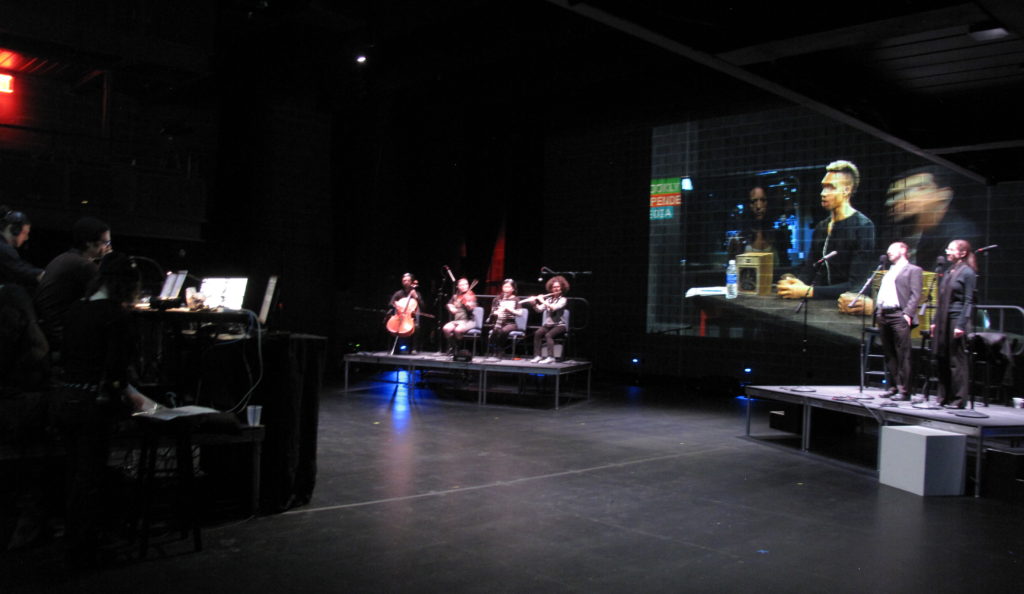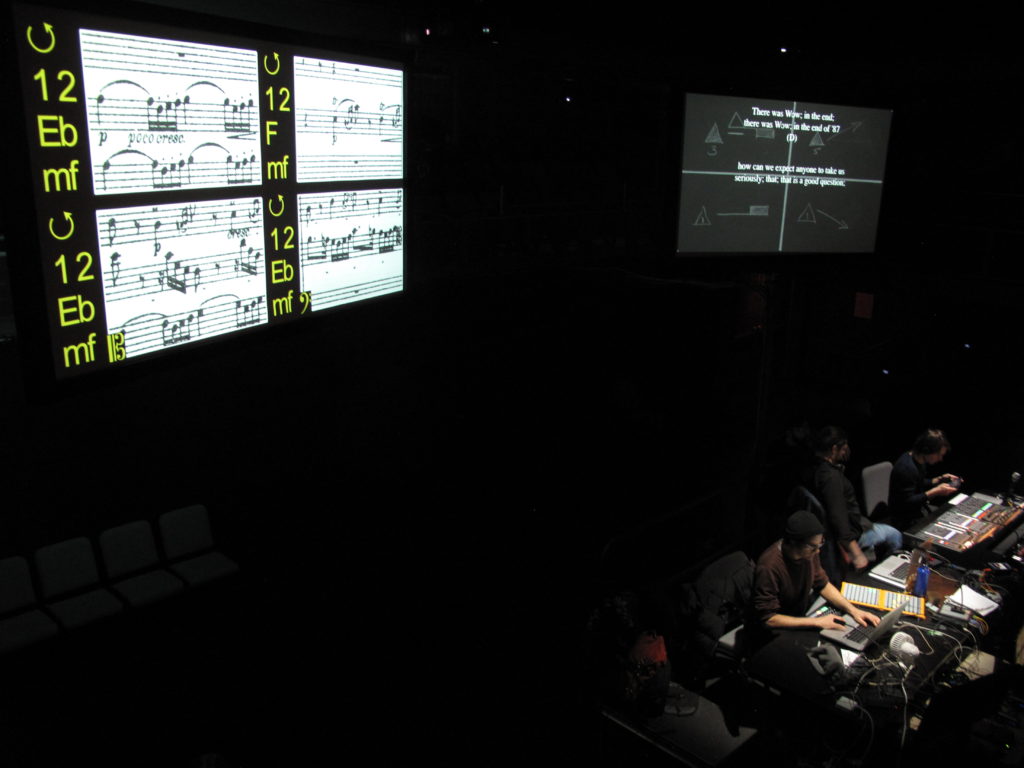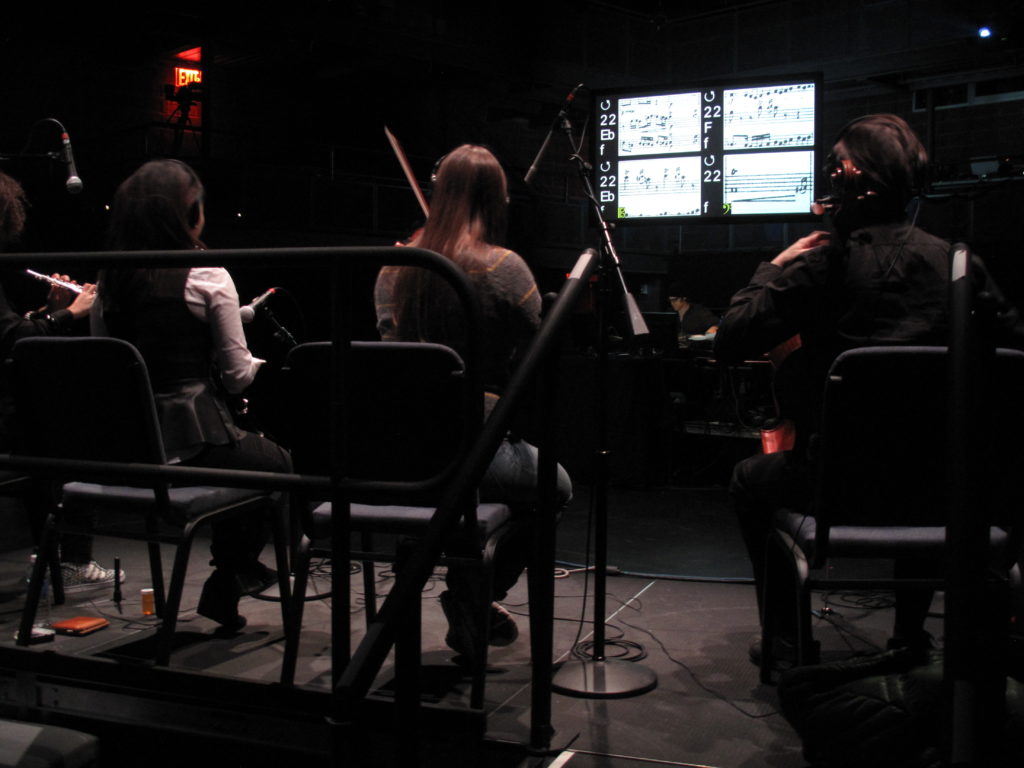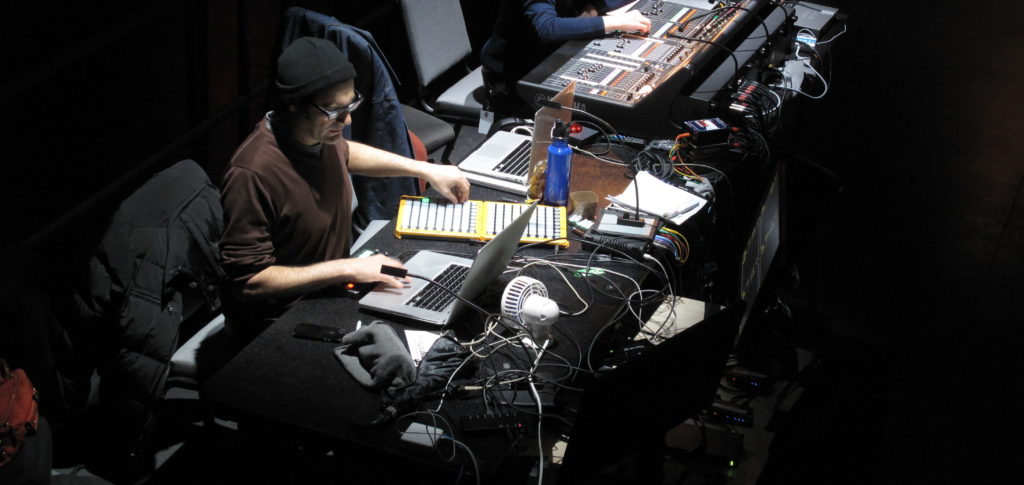WOW is an opera based on the infamous CD-skipping scandal of the 1980s pop duo Milli Vanilli. I composed the score to a libretto by Christian Hawkey and the premiere was staged by David Levine at BRIC | Media Arts in Brooklyn, NY.
I was interested in looking at how the scandal was the outcome of a music industry that was deeply racist on a structural level. Both the unknown session musicians and the frontmen themselves were manipulated by a white male record producer into a cycle of repetition and exploitation. I wanted to break out of this closed narrative by creating an open-ended score that would never repeat. During the performance both the orchestra and the singers read the score from a video that I’m generating as they play. The performers don’t know what measure is coming next, and a lot of the time I don’t either.
Layout of the Performance System
At the premiere, many people wanted to understand what was actually going on with my seemingly elaborate performance system, so I thought I’d go into some depth as to how WOW actually works. First, it’s important to know the physical layout of the environment. I am situated in the left of the photo at the table with the laptop etc. On the riser to my left is the four-piece chamber orchestra, and on the riser to my right are two of the singers (Seth Gillman and Alison Cheeseman).

Behind me are the two large projections of the score. On the left is the orchestral score and on the right, the vocal score, angled towards the appropriate musicians.

How the Orchestra Reads the Score
In the photo below the small orchestra (Cello, Violin/Viola, Clarinet/Oboe, and Flute) is performing the score, which I am generating as they play. Each musician reads from one of the quadrants, for example the violist here is reading the measure on the bottom left. The score is displayed one measure at a time and the musicians do not know what measure will follow. However, the performers are familiar with the material because the measures are all taken from a well-known score by Richard Wagner (more on that in a minute), that they have practiced in their original sequence. New measures appear on the upbeat so that the musician has a beat to take in what will happen next. Since the measures are delivered out of their original sequence often there are sudden and difficult jumps of register, dynamics, and phrases can be spliced in odd ways. I developed this system in close collaboration with the musicians, and went through a number of iterations before I finally found the balance between a constantly unpredictable score and something that is musically performable.

Here’s a bit from the overture, as it came out in one of the performances…
How the Orchestral Score Works
As raw material I used measures from Richard Wagner’s Meistersinger von Nurnberg, which seemed appropriate as his opera is basically about how to make the best popular song. I scanned pages from the full score of Wagner’s opera, and then cut up all the individual measures which could then be rearranged to create new combinations. For example the flute could play a section towards the end of the original score, while the oboe plays the beginning, and the cello and viola loop measures taken from the middle somewhere. The idea was to be able to deconstruct the layers in the original score and reassemble them.
Below is a video excerpt from the WOW orchestra score. As mentioned, each of the quadrants is dedicated to one of the four instrumentalists. The measures themselves have been individually extracted from Wagner’s Meistersinger (separately for each instrument) from the full orchestral score and tagged with a range of technical and musical properties. During the performance of WOW, the orchestral musicians will read these measures streaming onto a video monitor, knowing only on the upbeat which measure will be coming next.
The graphics to the left of each measure indicate whether the current measure will be looped, the key signature, and dynamics. Very often the performers play in a different meter than the original measure, for example, below these 4/4 measures are played in 5/8 by only playing the first 5 eighth notes of the measure, and then (in this case) repeating it. The larger number to the left of the time signature is always showing the current beat, and changes color on upbeats and downbeats. The biggest challenge for the musicians is keeping on top of the constantly changing, often asymmetrical, meters. Though the opera is harmonically quite straightforward, the metrical shifts are meant to capture a sense of the glitched CD loop that revealed Milli Vanilli to be lip-synching.
How the Singers Read the Score
The singers also read a dynamic score, though it is structured differently, and is not based on the Wagner measures. The libretto (by Christian Hawkey) is displayed one line at a time over a graphical notation for the vocal phrases that is also displayed without a predetermined sequence.
Here’s a section from one of the performances, just before the death of Rob (one half of Milli Vanilli)…

Again, each signer is assigned to a quadrant. This time they are reading a simple graphical score that indicates the scale degree to start their phrase on, and the direction of the melody. In the example below the singer reading the upper left quadrant begins the phrase on the third of the chord, moving up to its upper neighboring tone. The graphical notation, and the superimposed libretto text are independent of each other and recombine unpredictably for the performer. The vocal score is more open than the orchestral score to allow for any combination to work.
How I Generate the Score During the Performance
This is me, during a performance of WOW…

The laptop runs the software I created and a SQL database containing all the elements of the score: the Meistersinger measures, the libretto lines, and graphical vocal notation. The grid-like MIDI control surfaces under my left hand allow me to select these elements according to high-level parameters such as density of notes per measure, the degree of chromaticism, whether it is a lyrical melodic figure or arpeggiated accompaniment, etc. Basically, I decide during the performance what qualities I want in the various parts to have by pressing various button-pads and turning dials on another MIDI controller under my right hand. For example, I might want the flute to play a solo with large interval jumps and a medium amount of chromatic notes, while the other three instruments outline a major triad, all in A Major. Rather than directly choosing the measures, I just ask for these qualities — since in most cases there are many measures that fit the requirements — and my program selects the specific measures for me after querying a database in which all the measures have been tagged.
—
Andy Horwitz had a long talk with us about the process and wrote this feature on CultureBot.